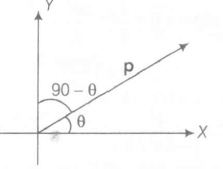Answer:
Option B
Explanation:

Torque applied on a dipole $\tau$ =pE sinθ where θ = angle between the axis of the dipole and electric field.
For electric field $E_{1}=E\hat{i}$
it means the field is directed along positive X direction, so angle between dipole and field will remain θ , therefore torque in this direction.
$E_{1}=pE_{1}sin\theta$
In electric field
$E_{2}=\sqrt{3}E\hat{j} $, it means field is directed along positive Y -axis, so angle between dipole and field will 90-θ
Torque in this direction
$T_{2}=pE \sin(90-\theta)$
$=p\sqrt{3}E_{1}\cos\theta$
According to question
$\tau_{2}=-\tau_{1}\Rightarrow \mid \tau_{2}\mid =\mid\tau_{1}\mid$
$\therefore pE_{1}\sin\theta =p\sqrt{3}E_{1}\cos\theta$
$\tan\theta =\sqrt{3}$
$\Rightarrow$ $\tan\theta =\tan 60^{0}$
θ = 60°